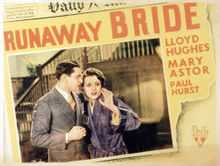The Runaway Bride (film)
| The Runaway Bride | |
|---|---|
 Film poster | |
| Directed by |
Donald Crisp[1] James Anderson (assistant) |
| Produced by | William Sistrom[2] |
| Written by | Jane Murfin[2] |
| Based on |
The play, Cooking Her Goose by Lolita Ann Westman and H. H. Van Loan[2] |
| Starring |
Mary Astor Lloyd Hughes Paul Hurst[2] |
| Cinematography | Leo Tover[2] |
| Edited by | Archie Marshek[2] |
| Distributed by | RKO Radio Pictures |
Release dates |
|
Running time | 69 minutes[3] |
| Country | United States |
| Language | English |
| Budget | $103,000[4] |
| Box office | $204,000[4] |
The Runaway Bride is a 1930 comedy film starring Mary Astor, Lloyd Hughes and Paul Hurst. It was directed by Donald Crisp, from a screenplay by Jane Murfin, adapted from the play, Cooking Her Goose, by Lolita Ann Westman and H. H. Van Loan.[5]
The film is preserved in the Library of Congress collection.[6]
Plot
Mary Gray and Dick Mercer are racing to Atlantic City, where they intend to elope, since Mary's wealthy parents would never approve of the marriage. In Atlantic City, they arrive at the humble efficiency hotel room Mary has rented. Dick is not impressed, and would prefer they stay in a fancier hotel. An argument ensues, ending with Dick storming out, leaving Mary alone.
While waiting for Dick's return, a jewel thief, Red Dugan, arrives at the hotel room, with a policeman, Sergeant Daly in hot pursuit. Desperate, Dugan secretes a stolen necklace in Mary's purse, before being shot and killed by Daly, who is himself wounded in the gun battle.
A chambermaid at the hotel, Clara Muldoon, suspects that the jewels have been passed to Mary. The police pick up Mary, Dick and Clara, but Mary is released. Attempting to flee from both Dick and the police, Mary seeks a job as a cook under an assumed name at the home of the wealthy bachelor, George Blaine. While there, a mutual attraction begins to develop between Mary and George. Clara, and the rest of the thieves' gang, trace Mary to Blaine's house, and abduct her while they recover the stolen jewels.
The gang takes Mary to a fake hospital, where they hold her against her will. Blaine tracks Mary down and rescues her, just before the police arrive to arrest the jewel thieves.
Cast
- Mary Astor as Mary Gray / Sally Fairchild
- Lloyd Hughes as George Edward Blaine
- Paul Hurst as Sergeant Daly
- David Newell as Dick Mercer
- Natalie Moorhead as Clara Muldoon
- Edgar Norton as Williams
- Francis McDonald as Barney Black
Notes
Although Donald Crisp was a seasoned director, with dozens of silent films under his belt, this would be the first and last talking film he ever directed.[7]
Reception
The film made a profit of $15,000.[4]
References
- ↑ "The Runaway Bride, Credits". Turner Classic Movies. Archived from the original on June 25, 2014. Retrieved June 25, 2014.
- ↑ 2.0 2.1 2.2 2.3 2.4 2.5 2.6 "The Runaway Bride: Detail View". American Film Institute. Archived from the original on March 29, 2014. Retrieved June 25, 2014.
- ↑ "The Runaway Bride: Technical Details". theiapolis.com. Archived from the original on June 25, 2014. Retrieved June 25, 2014.
- ↑ 4.0 4.1 4.2 Richard Jewel, 'RKO Film Grosses: 1931-1951', Historical Journal of Film Radio and Television, Vol 14 No 1, 1994 p56
- ↑ The AFI Catalog of Feature Films:The Runaway Bride
- ↑ Catalog of Holdings The American Film Institute Collection and The United Artists Collection at The Library of Congress p.156 c.1978 by The American Film Institute
- ↑ "The Runaway Bride: Articles". Turner Classic Movies. Archived from the original on June 25, 2014. Retrieved June 25, 2014.
External links
| ||||||||||||||